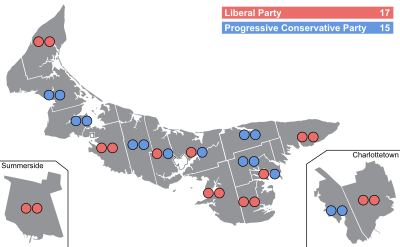1966 Prince Edward Island general election
The 1966 Prince Edward Island general election was held on May 30, 1966.[1]
| ||||||||||||||||||||||||||||||||||
All 32 seats in the Legislative Assembly of Prince Edward Island 17 seats needed for a majority | ||||||||||||||||||||||||||||||||||
|---|---|---|---|---|---|---|---|---|---|---|---|---|---|---|---|---|---|---|---|---|---|---|---|---|---|---|---|---|---|---|---|---|---|---|
| ||||||||||||||||||||||||||||||||||
 Seats won by each party per district. Voters elect two members (one Councillor and Assemblyman) from each of the 16 districts. | ||||||||||||||||||||||||||||||||||
| ||||||||||||||||||||||||||||||||||
The election in the riding of 1st Kings was delayed until July 11, 1966 due to the death of Liberal Assemblyman and candidate William Acorn.[2] As it turned out, other ridings elected a total of 15 Liberals and 15 Progressive Conservatives, and the riding of 1st Kings would by itself decide the general election.
The outgoing Progressive Conservative government attempted to win 1st Kings by resorting to such methods as naming one of the PC candidates (Keith Mackenzie) as Minister of Transports, and paving 30 miles of road in the district.[3] At the time, a reporter from the Charlottetown Guardian commented on how "the riding may well sink under the weight of the [paving] machines". The strategy failed as both Liberal candidates in 1st Kings ultimately won, giving the Liberals a 17 to 15 majority and enabling Liberal leader Alex Campbell to become Premier.
The 1966 election was the first following the splitting of the 5th Queens district. The Progressive Conservative government decided to break with the tradition of each county having five ridings and ten members; by splitting 5th Queens, it gave the city of Charlottetown two ridings and therefore four members. This was the single biggest change to the map since 1893 when the ridings were devised. In that time population shifts had made some changes needed, as Charlottetown's population was more than five times that of some of the more rural ridings. The Progressive Conservatives had hoped that traditionally Progressive Conservative Charlottetown would vote in two new Progressive Conservative members to the legislature; on election day the new riding elected two Progressive Conservatives, but the now modified old riding elected two Liberals.
Party Standings
| 17 | 15 |
| Liberal | PC |
| Party | Party Leader | Seats | Popular Vote | |||||
|---|---|---|---|---|---|---|---|---|
| 1962 | Elected | Change | # | % | Change | |||
| Liberal | Alex Campbell | 11 | 17 | +6 | 47,065 | 50.5% | +1.1% | |
| Progressive Conservative | Walter R. Shaw | 19 | 15 | -4 | 46,118 | 49.5% | -1.1% | |
Members Elected
The Legislature of Prince Edward Island had two levels of membership from 1893 to 1996 - Assemblymen and Councillors. This was a holdover from when the Island had a bicameral legislature, the General Assembly and the Legislative Council.
In 1893, the Legislative Council was abolished and had its membership merged with the Assembly, though the two titles remained separate and were elected by different electoral franchises. Assembleymen were elected by all eligible voters of within a district. Up until the 1962 election, Councillors were only elected by landowners within a district. The Shaw government passed an Act in 1963, eliminating this requirement.[4]
Kings
| District | Assemblyman | Party | Councillor | Party | ||
|---|---|---|---|---|---|---|
| 1st Kings | Bruce L. Stewart | Liberal | Daniel J. MacDonald | Liberal | ||
| 2nd Kings | Walter Dingwell | Progressive Conservative |
Leo Rossiter | Progressive Conservative | ||
| 3rd Kings | Thomas A. Curran | Progressive Conservative |
Preston MacLure | Progressive Conservative | ||
| 4th Kings | Lorne Bonnell | Liberal | Keir Clark | Liberal | ||
| 5th Kings | Cyril Sinnott | Progressive Conservative |
George J. Ferguson | Liberal | ||
Prince
| District | Assemblyman | Party | Councillor | Party | ||
|---|---|---|---|---|---|---|
| 1st Prince | Prosper Arsenault | Liberal | Robert E. Campbell | Liberal | ||
| 2nd Prince | George Dewar | Progressive Conservative |
Robert Grindlay | Progressive Conservative | ||
| 3rd Prince | Henry Wedge | Progressive Conservative |
Keith Harrington | Progressive Conservative | ||
| 4th Prince | Max Thompson | Liberal | |
Frank Jardine | Liberal | |
| 5th Prince | Earle Hickey | Liberal | Alexander B. Campbell | Liberal | ||
Queens
| District | Assemblyman | Party | Councillor | Party | ||
|---|---|---|---|---|---|---|
| 1st Queens | Frank Myers | Progressive Conservative |
Walter Russell Shaw | Progressive Conservative | ||
| 2nd Queens | Sinclair Cutcliffe | Liberal | Lloyd MacPhail | Progressive Conservative | ||
| 3rd Queens | Cecil A. Miller | Liberal | J. Russell Driscoll | Progressive Conservative | ||
| 4th Queens | J. Stewart Ross | Liberal | Harold P. Smith | Liberal | ||
| 5th Queens | Gordon L. Bennett | Liberal | Elmer Blanchard | Liberal | ||
| 6th Queens[5] | J. David Stewart | Progressive Conservative |
Alban Farmer | Progressive Conservative | ||
Sources
- "Provincial General Election Results, 1966" (PDF). Elections PEI. Archived from the original (PDF) on 2015-05-25. Retrieved 2015-05-25.
- Prince Edward Island Chief Electoral Officer report for 1966
- Political historian Wayne MacKinnon, as quoted on http://fruitsandvotes.com/?p=250
- Fred Driscoll. "History and Politics of Prince Edward Island" (PDF). Canadian Parliamentary Review.
- new riding